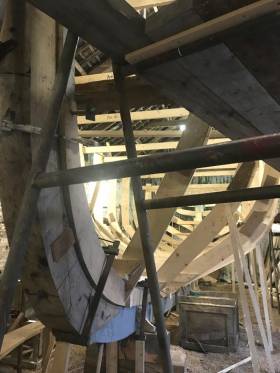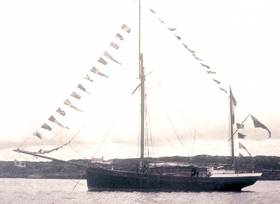Displaying items by tag: Conor O'Brien
Conor O'Brien Book Donated to Foynes Yacht Club as €1,000 Raised for RNLI at Presentation Night
Following Vincent Murphy's presentation on the life of circumnavigator Conor O’Brien at Foynes Yacht Club on the Shannon Estuary last Friday evening, Professor Patrick Frawley, a member of the Club, and a native of Foynes donated an unedited version of one of O’Brien’s books together with a number of first edition books that he had purchased from all over the world.
"We are delighted and honoured to receive these books and can’t thank Patrick enough for this very generous donation", FYC Vice Commodore Patricia McCormack told Afloat.
 Bev Lowes, FYC Commodore, The O’Brien Family from Foynes Island, Professor Patrick Frawley, and Patricia McCormack, FYC Vice Commodore
Bev Lowes, FYC Commodore, The O’Brien Family from Foynes Island, Professor Patrick Frawley, and Patricia McCormack, FYC Vice Commodore
FYC Commodore Bev Lowes thanked everybody for attending on the night and was delighted to see the O’Brien family from Foynes Island among the crowd. He thanked Vincent for his very informative presentation and Patrick for his donation.
€1,045 was raised for the RNLI.
Conor O’Brien was born in Cahermoyle House, Ardagh, Co Limerick, on the 3rd of November 1880 and lived on Foynes Island. He was educated in Winchester College and Oxford University in England, and at Trinity College, Dublin.
He was a heroic sailor with a huge commitment to Irish Home Rule – a fluent Irish Speaker – In 1914, he assisted Erskine Childers in the famous gun-running saga of Irish history, and then went on to circumnavigate the world in an amazing voyage.
After the war, he retired to his sister’s home on Foynes Island, Co Limerick where he lived and continued to write books until his death on the 18th of April 1952.
Down in West Cork, they have a way of quietly getting on with things until a major waypoint is inevitably passed in the project, and then we’re into new territory. For two or three years now, Liam Hegarty and his team of master shipwrights at Oldcourt Boatyard on the River Ilen have been engaged in constructing a re-creation of the 42ft Baltimore-built Saoirse. Aboard her, Conor O’Brien (1880-1952) of Foynes Island in the Shannon Estuary sailed round the world with several crew south of the great Capes and back to Ireland in exactly two years, between June 20th 1923, and June 20th 1925.
This means that Saoirse was being completed, commissioned and trial-sailed during the Civil War. While we don’t precisely know her launching date, it’s a fact that in August 1922 she was carrying passengers and mail out of West Cork, as the area’s road and rail communications had been cut off in the ongoing conflict.
 Despite the rugged challenge of her world-girdling voyage, Saoirse could provide homely comfort below – Conor O’Brien in the saloon as sketched by his wife Kitty Clausen in the 1930s
Despite the rugged challenge of her world-girdling voyage, Saoirse could provide homely comfort below – Conor O’Brien in the saloon as sketched by his wife Kitty Clausen in the 1930s
 A proper little ship. The skylight as seen in previous photo has been faithfully re-created, while the traditional arrangements of the foredeck have come back to life. Photo: John Wolfe
A proper little ship. The skylight as seen in previous photo has been faithfully re-created, while the traditional arrangements of the foredeck have come back to life. Photo: John Wolfe
It’s a side-story to an already extraordinary saga, and in retrospect it seems inevitable that the Centenary would be greeted with the appearance of a Saoirse replica, for the original – or most of her – was lost in a hurricane in Jamaica in 1979. But while virtually all of the fabric of the first Saoirse was gone, Gary Mac Mahon of the Ilen Project in Limerick has a very comprehensive archive of Saoirse data and drawings, including a set of hull lines take off by Uffa Fox in Cowes in 1927.
Thus with an extensive additional set of Conor O’Brien drawings and many photographs, it was possible to contemplate an authentic re-build, and in time the project was under-written - and the new Saoirse’s ownership with it - by Fred Kinmonth, a high-flying international corporate lawyer who has made his career in Hong Kong but has retained strong family connections with West Cork, where he has been increasingly resident in recent years.
 Happy at sea. Conor O’Brien relaxed on the helm as Saoirse makes knots in open water. With the raised after-deck, a special rail – “balustrade” almost - was fitted round the stern
Happy at sea. Conor O’Brien relaxed on the helm as Saoirse makes knots in open water. With the raised after-deck, a special rail – “balustrade” almost - was fitted round the stern
 Newly afloat, the re-born Saoirse awaits the fitting of the special rail around the raised afterdeck. Photo: John Wolfe
Newly afloat, the re-born Saoirse awaits the fitting of the special rail around the raised afterdeck. Photo: John Wolfe
For as long as the new Saoirse was under construction in the Top Shed at Oldcourt - where Ilen had been restored before her – there was a spiritually soothing dimension to the project, as the highly atmospheric Top Shed - or the Old Grain Store or whatever you want to call it - has the capacity to be an almost sacred space when a wooden vessel is under traditional construction.
 The sacred space. An early stage of construction for the new Saoirse in the unique atmosphere of the Top Shed at Oldcourt. Photo: W M Nixon
The sacred space. An early stage of construction for the new Saoirse in the unique atmosphere of the Top Shed at Oldcourt. Photo: W M Nixon
Yet inevitably the waypoint is approaching where the project would be better served by having the little ship afloat, and that occurred with Saoirse a few days ago. In one fell swoop, she went from being sheltered and cloistered, unable to view in all her totality in the confines of the shed, to a sudden state of total public display.
And she looks marvellous. Gallant. Jaunty. And saved from an unseemly dumpiness by the fact that master-builder Tom Moynihan in 1922 insisted on O’Brien adding an extra 2ft to the stern to provide a transom of robust elegance.
 “A transom of robust elegance”. Conor O’Brien masterfully using a yuloh to propel the engine-less Saoirse across the harbour in Ibiza in 1932
“A transom of robust elegance”. Conor O’Brien masterfully using a yuloh to propel the engine-less Saoirse across the harbour in Ibiza in 1932
It is fascinating to compare the photos and plans from the original vessel with what we see now. The new ship has been built with such integrity by the Hegarty team that she is an artefact of significance in her own right. To that, we add her historic role. And it is a matter of note that the original was born in 1922, which also saw the birth of the Cruising Club of America. The founding Commodore of the CCA was Bill Nutting, who sailed across the Atlantic with his ketch Typhoon to get the blessing for his proposed club from Claud Worth, who in those days was the guru of world cruising, his thoughts on deep sea sailing seen as being in the realms of sacred scripture.
Thus in time, the definitive opinion on the world-girdling voyage of the Saoirse was given by Claud Worth in his Foreword to O’Brien’s classic book Across Three Oceans:
“Mr O’Brien’s plain seamanlike account is so modestly written that a casual reader might miss its full significance. But anyone who anything of the sea, following the course of the vessel day by day on the chart, will realize the good seamanship, vigilance and endurance required to drive this little bluff-bowed vessel, with her foul uncoppered bottom, at speeds from 150 to 170 miles a day, as well as the weight of wind and sea which must sometimes have been encountered…..however common ocean voyages in small yachts may become, Mr O’Brien will always be remembered for his voyage across the South Pacific and round the Horn.”
For sure, we all carry an image of Saoirse in our mind’s eye. And some of us can remember the original when she made her last visit to Ireland, on a voyage to Iceland in 1974. But it would take a heart of stone to be un-moved by this living vision which is now afloat in West Cork, the vibrant re-created reminder of an extraordinary voyage.
 The voyage begins. Saoirse getting underway in Dun Laoghaire on June 20th 1923
The voyage begins. Saoirse getting underway in Dun Laoghaire on June 20th 1923
While everyone else was staring goggle-eyed at rapidly-changing and decidedly hostile weather charts last Thursday, and wondering whether the weekend's racing was going to be possible at all, in typical style the always-amazing Gary MacMahon was at sea off our most exposed southwest coast in the lovingly-restored 56ft Conor O'Brien ketch Ilen, homeward bound to Limerick after the annual overhaul with Liam Hegarty at Oldcourt above Baltimore.
Since her very special Limerick to West Greenland voyage in 2019, the pandemic has meant the Ilen has been largely Kinsale-based in summer, sailing as much as was permissible for the Sailing into Wellness programme and other worthwhile causes. And her passage home after the annual check-up at Oldcourt – where she was painstakingly restored – has tended to involve freakishly gentle Autumn weather.
 When the going was gentler, and full sail could still be carried. Photo: Gary Mac Mahon
When the going was gentler, and full sail could still be carried. Photo: Gary Mac Mahon
 Weathering Cape Clear, with the end of the Mizen Peninsula fine on the starboard bow. Photo: Gary MacMahon
Weathering Cape Clear, with the end of the Mizen Peninsula fine on the starboard bow. Photo: Gary MacMahon
But this year, needs must when the devil drives. For whatever reason, the enigmatic Director of The Ilen Marine School found he was obliged to make the passage in the latter half of last week, and come hell or high water – literally – he did so. He admitted to it being a "wild ride", but the gallant 1926 Conor O'Brien creation – Ireland's only surviving traditional trading ketch – came through it with style, arriving into the Ted Russell Dock in Limerick without a feather out of place.
 The highest ocean swells on the West Coast of Ireland come in to the north of the Dingle Peninsula. Photo: Gary Machon
The highest ocean swells on the West Coast of Ireland come in to the north of the Dingle Peninsula. Photo: Gary Machon
Gary is a very visual person in his way of thinking, and we've received a sheaf of un-captioned photos and a couple of anonymous vid clips sent to tell the story. Thus we're winging it with the captions, but so what? – he and his shipmates did it, and did it with style. And there's a special unity to our Great Southwestern Seaboard which makes precision of location of secondary importance,
 The Ilen sailing well in more sedate conditions. Photo: Gary Mac Mahon
The Ilen sailing well in more sedate conditions. Photo: Gary Mac Mahon
Most people’s memories of the already pandemic-constricted Bank Holiday Weekend will be of Monday's wet and windy storm. But the training crew on the restored Conor O’Brien ketch Ilen of Limerick have only pleasant memories, as a fair weather passage around Ireland's magnificent southwestern seaboard from Winter Quarters in Kinsale saw them well ahead of the bad weather when they came into port at lunchtime Sunday, having rested until the tide made fair with the by-now traditional stopover at Carrigaholt.
The brief feeling of it being high summer already was emphasised by a Women’s Four racing shell from St Michael’s Rowing Club heading downriver with a welcoming eave from the cox. And by the time the storm struck, Ilen was safely and snugly in dock, and the racing shell was comfortably back in the boathouse. With Ilen now positioned in her home port, she is strategically located to swing into further action as soon as the easing of restrictions permits a further broadening of her activities.
Global circumnavigator and sailing ship designer Conor O’Brien (1880-1952) inevitably saw his most noted vessels, the 42ft world-girdler Saoirse and the 56ft trading ketch Ilen, being closely associated by the rest of the world with their birthplace in Baltimore. But much and all as he liked West Cork, he always insisted that ultimately his heart was in the Shannon Estuary on Foynes Island, where he was living when designed both vessels, and so he made a point of ensuring that they spent some time in the Foynes anchorage before going off on their great voyages. Thus although Saoirse’s pioneering cruise round the world south of the great Capes is generally thought to have started from Dun Laoghaire on June 20th 1923, O’Brien secretly reckoned it had got going from Foynes some weeks earlier. And equally, while the official records show that Ilen’s voyage to the Falkland Islands started from Avonmouth near Bristol on the 26th August 1926, as far as her skipper was concerned, the voyage had got under way from Foynes on the 28th July 1926.
There’s charming proof of this in the Foynes Harbour Master’s personal log from the 1920s. At the time, the HM was Hugh O’Brien, who was Conor O’Brien’s brother-in-law through marriage to one of the voyager’s sisters, while sharing his surname through being distantly related as a de Vere O’Brien of Curragh Chase. As Harbour Master, Hugh O’Brien was wont to embellish his records book with drawings of visiting vessels of special interest, and naturally, the new Ilen got the complete treatment in July 1926, resulting in very tangible evidence of Conor O’Brien’s assertion that this was the ship’s spiritual home port.
Now that Ilen has passed her biennial Department of Transport survey (as recently reported in Afloat.ie), the coming easing of pandemic restrictions means that plans are being firmed up for her programme in May, and she will shortly leave her winter berth in Kinsale to make the familiar passage round Ireland’s majestic southwestern seaboard towards Foynes, where Foynes Yacht Club have generously allocated a berth. This will enable the Ilen Marine School to implement as full a programme as the regulations at the time will permit, and the fact that it will see Ilen spend a longer period at her spiritual home than she ever has in her 95 years of existence will be a salute to the faithfully-kept records of Hugh O’Brien.
Ireland's Conor O'Brien was the first amateur skipper to circumnavigate the globe by the classic sailing ship route south of the great Capes, running down his easting in the big winds of the Great Southern Ocean which blow unhindered round the globe. But although his 42ft ketch Saoirse – which he'd designed himself – was often described as a "little ship", she was tiny by comparison with the enormous square-riggers which regularly plied this route.
Those majestic wind-jammers were already in decline as a commercial and maritime force by the time Saoirse and her owner-skipper from Limerick achieved their clear-cut "first", with the smallness of the vessel adding to the lustre of its unique glory. And now the Centenary is approaching, for Saoirse took her departure from Dun Laoghaire on the 20th June 1923, and returned on 20th June 1925, with a whole new generation of O'Brien admirers emerging to emphasise the importance of marking this very special achievement in as many appropriate ways as possible.
It is a real curiosity of Conor O'Brien's unique place in Irish life - and in our own and world maritime history - that enthusiasm for his achievements seems to come in such distinct generational waves. Every so often, somebody "discovers" O'Brien all over again, and the rest of us - who are already quietly but fully aware of the exceptionality of his achievement - get berated for not honouring his memory as it should be. So maybe the best thing at this stage is to attempt a timeline-factsheet to put some sort of Conor O'Brien memory structure in place.
Why do we remember Conor O'Brien?
In 1923-25, he became the first amateur skipper to circle the world south of the Great Capes.
What was his family background?
He was from a County Limerick land-owning family whose main home was the mansion of Cahirmoyle at Ardagh, 15 kilometres inland from the port of Foynes on the Shannon Estuary, and now better known as the place where the Ardagh Chalice was found.
His immediate family history?
His grandfather was William Smith O'Brien, the Young Ireland leader. His father – who rejected the Young Ireland policies – was married twice, and Conor O'Brien's older half brother was the artist Dermod O'Brien (1865-1945), who was President of the Royal Hibernian Academy from 1910 to 1945.
 Conor O'Brien: Portrait by Kitty Clausen
Conor O'Brien: Portrait by Kitty Clausen
When and where was Conor O'Brien born?
He was born on 3rd November 1880 in his mother's house in Kensington in London. His mother, of the Marshall family of Yorkshire, had a house in Kensington and a country place in Surrey, so Conor's boyhood saw winters in England and summers in Ireland, the Irish summers being spread between Cahirmoyle in Ardagh, a family property on Foynes Island, and summer holidays staying at Keatinge's Hotel at Derrynane in West Kerry where he learned to sail, though for many years his main sport was mountaineering, but he did compete successfully in rowing at school
 Conor O'Brien's first command, the 27ft former Naval whaler Mary Brigid at Derrynane
Conor O'Brien's first command, the 27ft former Naval whaler Mary Brigid at Derrynane
Which school did he attend?
Winchester College in England – he seems to have been a diligent enough pupil, but although he'd gone there as a scholar, he did not emerge with any special awards.
His university career?
Trinity College, Oxford, where he did a four-year course in chemistry, which he seems to have found increasingly uninteresting as he graduated with a Fourth Class Degree.
Further education?
A long-established interest in architecture was growing, and in 1903 he was apprenticed to a conservation architect in London, but somehow seems have been able to spend expanding amounts of his time in Dublin, where his brother has set up his increasingly successful artist's studio in 1901.
What did he work at in Dublin?
He did some architectural work for the Co-Op movement, mostly on new creameries, but was also involved in projects for St Mary's Cathedral in Limerick, where he was home as often as possible.
What was his Dublin life like?
It was one of contrasts, as he moved in artistic and creative circles, and was an enthusiastic supporter of the Arts & Crafts Movement. He was a founder member in 1907 of the United Arts Club, along with WB Yeats, George Russell, Constance Markievicz and many others in an eclectic group.
Yet at the same time, he was much involved in mountaineering, particularly in North Wales with a group that occasionally included Mallory and Irvine of Everest fame.
Holidays in Derrynane now included the 27ft former naval whaler Mary Brigid, which he sailed one summer round the coast to Dublin Bay, and then returned west via the Grand Canal and the Shannon.
When did he buy his first proper seagoing cruiser?
In 1910 he sold the Mary Brigid and a share in a house he had in Dublin, and bought the 17-ton 1871-built gaff cutter Kelpie, a hefty 46-footer, in Dun Laoghaire. In order to give himself a proper grounding in navigation, he joined the Royal Naval Volunteer Reserve, and in 1911 he cruised Kelpie round Ireland.
 Conor O'Brien and his sister Kitty aboard Kelpie off the west coast of Ireland, 1913.
Conor O'Brien and his sister Kitty aboard Kelpie off the west coast of Ireland, 1913.
The boat's enormous cutter rig had been problematic, so by the 1911 cruise he'd reduced it to ketch rig, and by 1913 he preferred to keep her if at all possible in Foynes, which he reckoned to be his true home.
How did he get involved with the gun-running with Erskine Childers and Asgard in 1914?
His cousin Mary Spring Rice was a participant in the pro-Home Rule gun-running planning by Alice Stopford Green, Erskine Childers and others in response to the industrial-scale gun-running by the Ulster Volunteers into Larne in April 1914, and she had hoped to bring her Foynes-based former sailing trawler Santa Cruz in support of Erskine & Molly Childers' Asgard to collect the German arms shipment at a rendezvous at the Ruytigen Lightship at the south end of the North Sea.
But her vessel was unready and probably unsuitable, and knowing that Conor O'Brien was now strongly sympathetic to the Home Rule movement, she asked if he would like to get involved with Kelpie. His reply was that he always got special enjoyment out of a cruise with added purpose, and as a result, in July 1914, Kelpie and her skipper waited with increasing (and noisy) frustration for the delayed Asgard to make the rendezvous in Cowes.
 In time of peace – Molly and Erskine Childers with Asgard's dinghy during a Baltic cruise in the early years of their marriage.
In time of peace – Molly and Erskine Childers with Asgard's dinghy during a Baltic cruise in the early years of their marriage.
Eventually, they met up, then despite fog, the lightship was found, and the two gun-laden vessels headed for Ireland. But although Asgard was able to make her famous entrance to Howth on Sunday, July 24th and unload all her guns in two hours, it was reckoned that the other landing on the beach at Kilcoole in County Wicklow would benefit from the services of a yacht with an auxiliary engine, and thus the Kelpie's guns were transferred to Sir Thomas Myles' auxiliary cutter Chotah in the shelter of St Tudwal's island on the Welsh coast, and successfully landed at Kilcoole next day.
The Great War broke out almost immediately, and the leading players in the gun-running went straight into service with the allies, Conor O'Brien getting through the war in mine-sweeping with the RNVR, with his unconventional attitude to life in general occasionally ruffling feathers.
What's the story about Conor O'Brien working for Michael Collins?
O'Brien returned from war service to find Ireland in increasing turmoil after the Easter Rising of 1916, and particularly after the massive pro Sinn Fein vote in the General Election of 1918. This led to the meeting of the First Dail, and the establishment of an alternative Irish government which ran in opposition yet parallel to the British administration headquartered in Dublin Castle. O'Brien offered the services of himself and the Kelpie to this alternative Government in which Michael Collins was the administrative and financial mastermind, and in 1919-1920 Conor O'Brien patrolled with Kelpie as a Fisheries Inspector & Advisor off the northwest and west coasts.
 Michael Collins' Fisheries Inspector helming Kelpie…….At sea, Conor O'Brien thought that wearing shoes of any kind was an affectation
Michael Collins' Fisheries Inspector helming Kelpie…….At sea, Conor O'Brien thought that wearing shoes of any kind was an affectation
What happened to Kelpie?
With the War of Independence being fought with increasing violence as 1920 drew on, O'Brien had mixed feelings about the way things were going, yet in 1919 despite the turmoil, he had managed to get himself elected a member of the Royal Cruising Club, proposed by the very unionist Commander Frank Gilliland of Derry, whom he'd met through the RNVR, and seconded by Erskine Childers, who was by that time a total independence republican.
The RCC membership was subsequently to serve O'Brien very well, and as a keen new member at a loose end when everyone in Ireland seemed to be on one side or another in a sort of war, he went cruising such that, in the summer of 1921, Kelpie was to be seen of the coast of Scotland while her owner and some mountaineering friends conquered every significant peak and cliff face in the Cuillins of Skye.
The Mountaineers weren't sailors, and anyway their leave had run out, so having departed towards Scotland from Dublin Bay at the beginning of the cruise, O'Brien decided to return to Foynes single-handed via Ireland's west coast. But persistent headwinds made him change plan and head for Dublin Bay instead.
 The Cullins of Skye provided a superb objective for what proved to be Kelpie's last cruise
The Cullins of Skye provided a superb objective for what proved to be Kelpie's last cruise
However, the wind headed again and lightened, and in beating slowly through the North Channel at night, he set an alarm clock to allow himself a brief sleep, but managed to sleep right through the alarm. In classic O'Brien style, he subsequently placed all blame on the German-made alarm clock. But either way, while her exhausted skipper slept deeply, the poor old Kelpie came gently ashore in the dark and fog on the rocky Scottish coastline close south of Portpatrick, and with the tide ebbing, Conor O'Brien realised he was watching the slow death of his ship. At dawn, he put everything he could find space for into Kelpie's dinghy while leaving just enough room for himself, and rowed away into the fog towards Portpatrick's little harbour.
If you were making a movie about Conor O'Brien's great round the world voyage, this would be where you'd start. Early morning. The fog still heavy on the calm sea, though with the first hint of sunlight. The only noise the sound of rowing. Out of the fog appears a man on his own in an incongruously over-laden dinghy. He rows past, and heads into the barely visible harbour entrance. We see him clamber ashore in the harbour, and walk up the quayside and on past the Portpatrick Inn. Conor O'Brien's life, though he doesn't quite realize it at the time, has changed in a way that will ultimately make him a legend among sailors.
What did the loss of Kelpie ultimately mean for Conor O'Brien?
With landed family fortunes declining as a result of the actions of the Land League and the Land Commission, he only had a very small private income, and little or no personal property. By the summer of 1921, Kelpie had become in effect his home. But in time he secured the insurance money for her loss, and he retreated to Foynes Island where he'd the use of a cottage, Barneen. There, he designed his ideal for an ocean-going long-distance vessel, and this was to become the 42ft Saoirse.
When and where was Saoirse built?
She was built by Tom Moynihan and his shipwrights and trainees in the Fisheries School Boatyard in Baltimore, West Cork in 1922. O'Brien had experience of the high quality of Moynihan's work through repairs made to Kelpie in his Fisheries Inspector days.
Was Ireland not engaged in Civil War in 1922?
Yes, and West Cork was one of the more active theatres, yet the boat-building continued, and after Saoirse was launched and sailing, O'Brien claims to have carried the mails for the Irish Post Office as their links ashore had been broken.
Was there anything seen by the sailing community as unusual about Saoirse's appearance in 1922?
Just about everything. O'Brien deliberately went for an archaic hull and rig using long-proven equipment. But the accommodation was ahead of its time. While he once claimed that Saoirse was in effect a seagoing Art & Crafts cottage, she certainly was cosy down below, and he ensured that unlike Kelpie, the galley was right aft in the location of minimal movement at sea, very much ahead of the times in 1922.
 Saoirse on the slipway is revealed to have as simple a hull as possible
Saoirse on the slipway is revealed to have as simple a hull as possible
Had Conor O'Brien any significant ocean-voyaging experience under sail before he created Saoirse?
No. But he reckoned his time with Kelpie on Ireland's west coast - week in, week out - had taught him much about the needs of a vessel suitable for many ocean conditions, and this experience had been augmented by his time mine-sweeping with trawlers on a year-round basis during the Great War. In addition, the hugely experienced Tom Moynihan quietly persuaded him to make design modifications which improved Saoirse in many ways.
How long had he had the notion of a Round the World Voyage in mind?
We don't know, for initially, he would only admit that he was voyaging to New Zealand to join a climbing expedition. But he didn't deny the logic of coming home by way of Cape Horn.
Why did his voyage start from the Royal Irish Yacht Club in Dun Laoghaire?
He'd been associated with the club since at least 1910, and knew that it would provide the ideal setting for the highly-publicised departure of the first vessel to undertake an ocean voyage under the Tricolour ensign of the Irish Free State, with the name Saoirse celebrating both the freedom of the seas, and the new independence of Ireland. But in his heart of hearts, he reckoned all his voyages ultimately began and ended at Foynes.
 O'Brien had Saoirse rigged as a proper little ship, with her offwind rig including stun'sails.
O'Brien had Saoirse rigged as a proper little ship, with her offwind rig including stun'sails.
Did Saoirse's departure garner significant attention?
Yes. The going-away party seems to have begun at the United Arts Club in Dublin, and then became a moveable feast to the RIYC in Dunleary (as O'Brien called it), and then on to Saoirse herself before she finally managed to getaway.
How was public interest maintained?
One of his crew members for the early stages was contracted to file reports to the Irish Times from each port visited, and O'Brien himself had a natural talent for writing. Thus while Saoirse was away for only two years, he managed to get extensive logs into three consecutive annual editions of the Royal Cruising Club Journal, which in a sense gave his voyage official sailorly approval at a very senior level.
What were Saoirse's crewing arrangements?
Difficult. O'Brien was notorious for his impatient and outspoken bad temper. He only settled down as he got far out to sea, and in some ways was the living embodiment of Dr Johnson's comment that when a man gets to like a sea life, then he is not fit to live on land.
 "Not fit to live on land……" Conor O'Brien happy at the helm in a good breeze far at sea, and so sure of Saoirse's sea kindliness that he's dressed as though for a summer's day in Ireland
"Not fit to live on land……" Conor O'Brien happy at the helm in a good breeze far at sea, and so sure of Saoirse's sea kindliness that he's dressed as though for a summer's day in Ireland
It's reckoned that he'd got through something like 18 different crew-members by the time Saoirse returned to Dublin Bay, and when he got a compatible and able shipmate, events conspired to make it a short relationship.
The classic instance of this was in the Southern Indian Ocean, which – like many others subsequently following the same route – O'Brien found to be the roughest part of the entire voyage. Saoirse was running before "a moderate gale", and to his satisfaction, this excellent shipmate was making as good a job of the helming as O'Brien would have expected of himself.
Then they both noticed that somewhat over a mile away, a pinnacle wave was forming, with the three-way ocean swell building into an Everest of the ocean which eventually collapsed on itself in an enormous roar of hundreds of thousands of tons of breaking water. Neither of the two on deck said anything, but O'Brien was soon noting in the log that if Saoirse had been caught up in that, she wouldn't have had a chance. As for the highly-regarded sailor, when they reached Adelaide in Australia, he simply disappeared ashore with all his belongings and papers, and wasn't seen again.
When did Saoirse round Cape Horn?
"On the evening of Tuesday, December 2nd 1924, a small bluff-bowed 42ft gaff-rigged ketch of antique appearance approached Cape Horn from the west. The weather had been unsettled with winds from several directions, and two days previously, squalls from the northeast had brought flurries of snow, despite it being early in the southern summer. But conditions were improving as the Horn came abeam around 2200hrs in the last of the daylight.
With the onset of the short southern summer night with its brief token darkness, the wind settled in the north, and the little ship made steady progress. By noon on Wednesday in fine conditions, she had made good 140 miles in 24 hours, aided by a favourable current of at least one knot.
Superb visibility enabled the ketch's crew to admire the massive scenery along the rugged coast as they shaped their course to pass eastward of Staten Island. The wind then drew fresh and favourably from the southwest, and despite progress being slowed by their vessel's fouled bottom - for they had been at sea for more than 40 days since leaving New Zealand – by Saturday, December 6th they were moored in Port Stanley in the Falkland Islands."
 "This bluff-bowed little ship". Saoirse's lines as taken off by Uffa Fox in 1927
"This bluff-bowed little ship". Saoirse's lines as taken off by Uffa Fox in 1927
Why did it take Saoirse nearly six months to finish the global voyage from the Falklands back to Dun Laoghaire?
They stayed for six very hospitable weeks in the Falklands, and finally departed with the possibility of two useful contracts. One of the crew had formed a close relationship with an Islands woman, and took his departure from Saoirse in a South American port to return to the Falklands and marry her. As for his skipper, the islanders were so impressed by Saoirse that they started planning how best to persuade the rather economically-minded Falklands Islands Company to commission Conor O'Brien to design and organize the building of a larger sister to serve as the inter-island ferry.
What happened when Saoirse returned to Dublin Bay on Saturday, June 20th 1925?
Dublin Bay Sailing Club cancelled their racing for the day so that their fleet could provide a Guard of Honour. There was a boisterous initial welcome at the Royal Irish YC, and then a public parade into Dublin – reputedly watched by at least ten thousand cheering spectators - with O'Brien travelling in a ceremonial pony-drawn carriage to the United Arts Club, which provided a Gala Dinner on the Saturday night.
What happened then?
Fortunately, O'Brien had much to keep him busy. Before the year was out, the contract for the building of a 56ft trading ketch for the Falkland Islands had been finalized. The Ilen was under construction in Baltimore by1926, and in late summer O'Brien himself – crewed by cousins Con and Denis Cadogan from Cape Clear – sailed her out to the Falklands, with the Ilen registered as a yacht in the RIYC listing, as that was the only way her delivery skipper could get insurance.
 Full circle. The restored Ilen at the Royal Irish YC in Dun Laoghaire in May 2019, before her voyage to West Greenland. Photo: W M Nixon
Full circle. The restored Ilen at the Royal Irish YC in Dun Laoghaire in May 2019, before her voyage to West Greenland. Photo: W M Nixon
When did his major book of the voyage, Across Three Oceans, first get published?
Early in 1927, by Edward Arnold of London, and it was a publishing success. Apart from the engaging style of O'Brien's writing, it showed how cleverly he had placed himself through his link to the Royal Cruising Club, set up in the unlikely year of 1919 by the even more unlikely combination of Frank Gilliland and Erskine Childers.
Joining the RCC meant he came to the notice of the Club's Vice Commodore, Claud Worth. Worth was the undisputed guru of British cruising at the time, and his reach was such that his encouragement played a significant role in persuading Bill Nutting to bring the Cruising Club of America into being in 1922.
For much of the 1920s, Worth was the adjudicator for the Royal Cruising Club's annual awards, and despite the fraught situation in relations between Ireland and England, he awarded Conor O'Brien the RCC's premier trophy the Challenge Cup - which dated from 1896 – three years in a row in 1923, '24 and '25.
Subsequently, the ultimate supportive gift from Claud Worth was the foreword he provided for Across Three Oceans, in which two of his thoughtful paragraphs defined Conor O'Brien's achievement:
"…anyone who knows anything of the sea, following the course of the vessel day by day on the chart, will realize the good seamanship, vigilance and endurance required to drive this little bluff-bowed vessel, with her foul uncoppered bottom, at speeds of 150 to 170 miles a day, as well as the weight of wind and sea which must sometimes have been encountered…..
….. however common long ocean voyages in small yachts may become, Mr O'Brien will always be remembered for his voyage across the South Pacific and round the Horn."
What happened to Conor O'Brien after 1927?
Buoyed by the success of Across Three Oceans and with additional funds from the fulfilment of the Ilen contract, he made a very clever job of converting Saoirse to set more canvas in a sort of schooner rig while still using the original masts, and he entered her for the 1927 Fastnet Race. He was feted in Cowes, with Uffa Fox slipping Saoirse in order to taking off her lines, while Maurice Griffiths, Editor of Yachting Monthly, joined the crew for a Fastnet Race which Saoirse didn't actually finish as her new schooner rig didn't suit the endless windward work which prevailed, but the experience of sailing with O'Brien was further immortalised by Griffiths.
Had he any family life after 1927?
Yes, on October 10th 1928, soon to be 48, he married the 42-year-old Kitty Clausen, daughter of the artist George Clausen. She looked younger then her years, and although not a sailor, she genuinely shared Conor's enthusiasm for the nomadic lifestyle on Saoirse. Her family's summer life was centred around Cornwall, and Conor was happy to be based there at St Mawes on the east side of Falmouth Harbour, as he was finding the new inward-looking Ireland which was emerging after Independence to be claustrophobic, something which was unpleasantly exemplified in his beloved Baltimore, where the Fisheries School – formerly an exemplary charitable institution - had been taken under the notoriously harsh remit of the Industrial Schools.
 The newly-weds. Conor and Kitty hoisting sail aboard Saoirse – in best big ship style, he was happy to incorporate chains in his halyards
The newly-weds. Conor and Kitty hoisting sail aboard Saoirse – in best big ship style, he was happy to incorporate chains in his halyards
 Domesticity below – Conor in Saoirse's homely saloon
Domesticity below – Conor in Saoirse's homely saloon
Where did Conor and Kitty cruise in Saoirse?
For much of the early 1930s, they were in the Mediterranean, based for some time in the Balearics, and one year getting as far east as Greece. They wrote books together about it, Conor doing the writing and Kitty the sketches. But in time, Kitty was showing signs of developing illness, and they returned to Cornwall in 1935 and she died there in 1936, it is believed of leukaemia. Conor designed her headstone for a grave he and the Clausen family had managed to secure under an impressive pine tree in the beautiful waterside churchyard of St Just-in-Roseland - it is a peaceful place.
 "A peaceful place" – Kitty Clausen's headstone in St Just in Roseland, one of the last architectural design tasks undertaken by Conor O'Brien
"A peaceful place" – Kitty Clausen's headstone in St Just in Roseland, one of the last architectural design tasks undertaken by Conor O'Brien
Conor O'Brien died in 1952 aged 72 on Foynes Island – what had he been doing since becoming a widower in 1936?
He continued to live on Saoirse in Falmouth, but his heart was no longer in sailing her, and an Irish crew who called there on a cruise in 1937 found Saoirse to be hauled into the shed in Falmouth Boatyard with Conor still living onboard, seemingly sustained largely by tins of baked beans. However, among those who appreciated it, his writings on voyaging were still appreciated, and small books about yacht design and equipment still appeared – published by Oxford University Press - together with magazine articles which added to a set of works which included a couple of adventure books aimed at a younger readership
How did he become involved with a World War II posting in New York?
He finally sold Saoirse to English owner Eric Ruck in 1940, thus although he is completely identified with the boat, he only owned her for 18 years. In 1940, through old RNVR contacts from World War I, he got a posting as Dispatch Officer in New York for ferry crews delivering American-supplied vessels for the Royal Navy across the Atlantic, and while this programme lasted until 1944, he enjoyed himself hugely, stimulated by the city's new architecture and can-do attitude to life, and re-vitalised by having a clearcut job to do.
 Saoirse sailing in Eric Ruck's ownership, with the formerly loose-footed mainsail now fitted with a boom.
Saoirse sailing in Eric Ruck's ownership, with the formerly loose-footed mainsail now fitted with a boom.
His final years?
In 1944, aged 64, he returned to Ireland and up-graded the cottage of Barneen at the west end of Foynes Island to be his home, though he shared the day's main meal with relatives who lived in the island's main house. He produced occasional writings and technical drawings and built at least one elegant clinker punt which he would row across to Foynes for some surprisingly convivial pints of Guinness.
He died on Foynes Island of congestive heart failure in 1952 aged 72, and after a well-attended funeral in Foynes, was buried at nearby Loghill Church, overlooking his beloved Shannon Estuary.
What has happened to Ilen and Saoirse?
Ilen was brought back to Ireland under the inspiration and hands-on leadership of Gary MacMahon of Limerick in 1997, and in 2018 a major restoration was completed in a joint project between the Ilen Boat-Building School of Limerick and Liam Hegerty's boatyard at Old Court upriver from Baltimore in West Cork. In 2019 she voyaged to East Greenland, and has worked extensively with the Sailing Into Wellness programme, and several educational and environmental projects.
 Gary MacMahon
Gary MacMahon
 The spirit of Conor O'Brien lives on – Ilen in Greenland, July 2019. Photo: Gary Mac Mahon
The spirit of Conor O'Brien lives on – Ilen in Greenland, July 2019. Photo: Gary Mac Mahon
The Saoirse came ashore on a beach in Jamaica in the aftermath of a hurricane in 1979, but enough of her and her Ship's Papers were saved for Gary Mac Mahon to buy the rights to the registered vessel, and she is now being re-built by Liam Hegarty in Old Court.
How has the memory of Conor OBrien and his achievements been commemorated?
In 1929 he as made the first Honorary Member of the newly-formed Irish Cruising Club, and attended some of its functions in the late 1940s. And there are several memorials in the Foynes area and a model of Saoirse.
In 1998, to mark the 75th Anniversary of Saoirse's global circumnavigation, the Irish members of the Royal Cruising Club funded the sculpting of a bust of Conor O'Brien, carved by West Cork sculptor Danny Osborne (he created the Oscar Wilde reclining statue in Merrion Square) from a single vertebra of a giant blue whale which had been found on a beach on Ireland's Atlantic coast.
 Conor O'Brien discovered in the single vertebra of a blue whale, as carved by Danny Osborne to commemorate the 75th Anniversary of his completed circumnavigation in 1998
Conor O'Brien discovered in the single vertebra of a blue whale, as carved by Danny Osborne to commemorate the 75th Anniversary of his completed circumnavigation in 1998
The O'Brien bust was presented to the RIYC at a 75thAnniversary memorial lunch in October 1998, attended by many members of his family and others from Limerick and elsewhere who have kept the Conor O'Brien name and achievements prominent.
As it happens, there is a prominently-placed O'Brien statue in Dublin, but it is in memory of his grandfather William Smith O'Brien. Having originally been first placed on the South Quays in 1870, in 1929 it was moved to its current position of considerable honour in O'Connell Street. Yet even in this age when the political correctness or deeper significance of statuary can be a matter of heated debate, it is doubtful if many of those who hurry past the O'Brien statue in non-pandemic times have the slightest awareness of what it signifies. So in trying to provide a meaningful memorial to Conor O'Brien of Saoirse and what he achieved, perhaps the best place is right here, online.
 The William Smith O'Brien monument in its place of prominence in Dublin's O'Connell Street. But in today's rushed and screen-dominated world, does anybody really appreciate the full meaning of another piece of urban statuary?
The William Smith O'Brien monument in its place of prominence in Dublin's O'Connell Street. But in today's rushed and screen-dominated world, does anybody really appreciate the full meaning of another piece of urban statuary?
Irish Sailors, the Golden Globe & Cape Horn After 94 Years
On most coastlines in the world, you’ll invariably hear of some challenging nearby headland being referred to as “the local Cape Horn” writes W M Nixon
No other promontory worldwide has the same global image. It tells us much about the fearsome reputation of South America’s most southerly point, jutting as it does into the turbulent waters of the Great Southern Ocean where it becomes the Drake Passage, with Antarctica itself not so very far away across some of the roughest seas on the planet.
Cape Horn is always on the oceanic sailing agenda. And at the moment it is top of the list, with 73-year-old Jean-Luc van den Heede of France, leader in the Gold Globe Golden Jubilee Race, rounding it a week ago, while second-placed 41-year-old Dutchman Mark Slats (in a much-depleted fleet) will soon be there, albeit more than a thousand miles astern of van den Heede.
They and the remaining sailors in this challenging re-enactment are following in the wake of solo skipper Robin Knox-Johnston fifty years after he became the first man to sail round the world non-stop in Suhaili, with Knox-Johnston and his little ketch undoubtedly achieving one of world sailing’s truly great firsts.
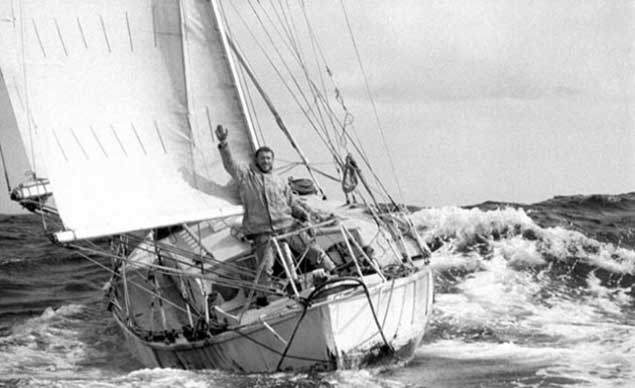 One of world sailing’s most enduring images – Robin Knox-Johnston aboard Suhaili in 1969, approaching the conclusion of his non-stop global circumnavigation
One of world sailing’s most enduring images – Robin Knox-Johnston aboard Suhaili in 1969, approaching the conclusion of his non-stop global circumnavigation
But by the time Suhaili rounded Cape Horn on 17th January 1969, a number of small sailing boats had done so before her, though none in the same epic non-stop world-girdling style. However, some 45 years had elapsed since the first rounding of Cape Horn by a small cruising boat which had crossed the southern reaches of the South Pacific to get there. But though it was hailed afterwards as the great pioneering achievement it genuinely was, at the time those involved seemed to handle it in an almost low key way, however much it may have meant to them personally.
It was the evening of Tuesday, December 2nd 1924 (94 years ago this Sunday) when the small bluff-bowed 42ft gaff-rigged Irish ketch Saoirse, a craft of antique appearance, approached Cape Horn from the west. The weather had been unsettled with winds from several directions, and two days previously, squalls from the northeast had brought flurries of snow despite it being early in the southern summer. But conditions were improving as the Horn came abeam around 2200hrs in the last of the daylight.
 Conor O’Brien’s Saoirse departing Dun Laoghaire for her global circumnavigation, June 20th 1923. She returned precisely two years later on June 20th 1925, after becoming the first small craft to run down her easting in the Great South Ocean from New Zealand to round Cape Horn. Photo: Irish Times
Conor O’Brien’s Saoirse departing Dun Laoghaire for her global circumnavigation, June 20th 1923. She returned precisely two years later on June 20th 1925, after becoming the first small craft to run down her easting in the Great South Ocean from New Zealand to round Cape Horn. Photo: Irish Times
With the onset of the short southern summer night with its brief darkness, the wind settled in the north, and the little ship made steady progress. By noon on Wednesday in fine conditions, she had made good 140 miles in 24 hours, aided by a favourable current of at least one knot. Superb visibility enabled the ketch’s crew to admire the massive scenery along the rugged coast as they shaped their course to pass eastward of Staten Island. The wind then drew fresh and favourably from the southwest, and despite progress being slowed by their vessel’s fouled bottom - for they had been at sea for more than 40 days since leaving New Zealand – by Saturday December 6th they were moored in Port Stanley in the Falkland Islands.
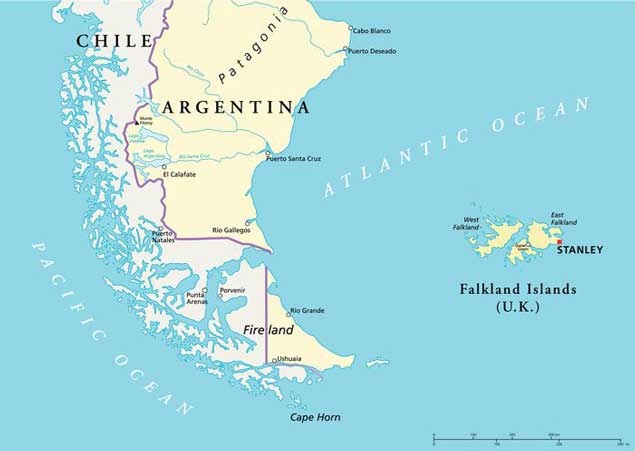 By being so far south in totally exposed waters, Cape Horn is often a huge challenge for small sailing craft
By being so far south in totally exposed waters, Cape Horn is often a huge challenge for small sailing craft
In rounding Cape Horn, the ketch’s amateur skipper Conor O’Brien (1880-1952) of Foynes Island on the Shannon Estuary had made the breakthrough towards becoming the first to take a small yacht around the world south of the Great Capes, running down his easting across the full width of the far Southern Pacific through everything that the Roaring Forties and Screaming Fifties could throw at him.
He faced it with some confidence, as his little vessel had successfully negotiated several ocean storms during her long passage from Dublin Bay. Ironically, it was in the warm and sunny latitudes of the Canary Islands that they had experienced one of their most severe tests, logging a day’s run of 185 miles while driving hard in rough seas in a sharp gale of the northeast trade winds.
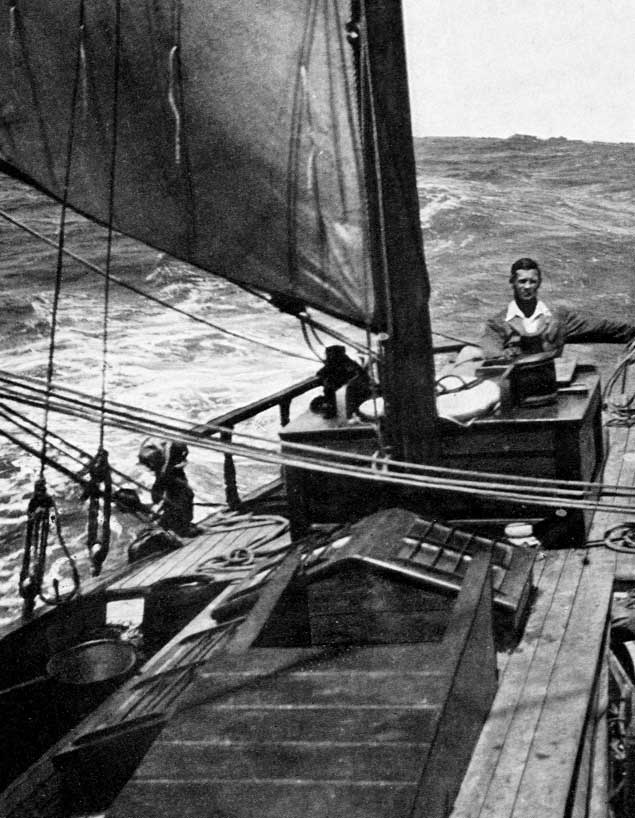 Conor O’Brien was at his most content far at sea, helming Saoirse in markedly relaxed style. Although a “bluff-bowed little vessel”, as indicated here, Saoirse was well capable of good speeds with comfort
Conor O’Brien was at his most content far at sea, helming Saoirse in markedly relaxed style. Although a “bluff-bowed little vessel”, as indicated here, Saoirse was well capable of good speeds with comfort
But O’Brien’s own-designed little ship, soundly built by Tom Moynihan and his craftsmen at the Fisheries School in Baltimore in 1922, proved well able, and continued to log many excellent 24-hours runs. The most severe conditions were experienced between southern Africa and Australia, yet the ketch seemed to lead a charmed life. Although he and his shipmates observed several huge pinnacle breakers caused by intersecting wave patterns which he felt sure would have overwhelmed his vessel had she been caught up in one of those mega-breakers, it never happened, and the long haul across the southern Pacific to curve southward to round Cape Horn was subsequently recounted in an under-stated tone. But then, that was the style of the era and the milieu from which Conor O’Brien had emerged.
O’Brien may have been rewarded with a fairly gentle rounding of the Horn itself, but the very small world of ocean voyagers at the time had no doubt of the quality of his achievement. Although Joshua Slocum in Spray had negotiated his way westward from the Atlantic to the Pacific through the channels north of Cape Horn some 28 years earlier, the weather he’d experienced, coupled with the historical stories from the crews of much larger sailing ships which had succeeded in rounding the Horn – for many failed in the attempt – left no doubt about the extremely changeable and often ferocious conditions which were central to the challenge O’Brien had faced.
 Conor O’Brien designed Saoirse himself, and while she was basically of old-fashioned style, she was way ahead of most boats of the time in having the galley well after in the area of least motion
Conor O’Brien designed Saoirse himself, and while she was basically of old-fashioned style, she was way ahead of most boats of the time in having the galley well after in the area of least motion
For circumnavigator sailors from Europe, once you’ve rounded Cape Horn and returned to Atlantic waters, there’s a reassuring feeling of being on the home stretch, for all that there are ten thousand miles still to sail. Certainly O’Brien and his crew of two became so relaxed that they spent six weeks in the Falklands over the Christmas period, becoming so much part of the local community that a crew-member married a local girl and much of Saoirse’s subsequent voyage northward through the Atlantic was made with just two on board.
Yet although it all continued to be done in a low key style, O’Brien was no slouch when publicity opportunities arose, and he returned to Dun Laoghaire on Saturday June 20th 1925 – two years to the day since he departed – in order to facilitate a rapturous welcome. Dublin Bay Sailing Club even cancelled their Saturday racing programme so that their members could join the fleet welcoming Saoirse home.
For most of the voyage, however, Saoirse and her crew were totally out of contact, and could get on with traversing the oceans in traditional lone ship style. And 45 years later, there were long periods in 1968-69 when Robin Knox-Johnston’s location with Suhaili was a matter of speculation rather than precision – it was something of a surprise when the battered but unbowed little ketch appeared in the distant approaches to Falmouth to claim an indisputable “first”.
But today, a constant flow of information in every shape and form is central to any major oceanic sailing event. The Golden Jubilee of the Golden Globe is supposed to be a retro event in which the participants sail old-style boats of closed hull profile using only the technology available in 1968. But the demands of the 21st century with its multiple communication technologies means that the outside world knows almost everything that is going on in this nine month saga.
Thus when Jean-Luc van den Heede had passed Cape Horn a week ago, it so happened that the AGM of the Old Cape Horners Association was being held in England’s historic naval harbour of Portsmouth, and they were provided with a radio linkup with the 73-year-old Frenchman who revealed that it was in fact his tenth rounding of the Horn, and his most recent visit had been during a cruise in the area when they’d landed at Cape Horn island’s semi-sheltered bay, and had gone visiting with the lighthouse keepers for all the world like cruisers of yore making their way along the west coast of Ireland or through the Hebrides.
 Image of a great seaman – the 73-year-old Jean-Luc van den Heede. He has completed his tenth rounding of Cape Horn, leading the Golden Globe Golden Jubilee Race. On his ninth rounding, he was cruising, and he and his crew went ashore and visited the lighthouse keepersThis almost light-hearted approach to the realities of Cape Horn is classic van den Heede, for in order to still be in the lead in the Golden Globe, he had to survive a knockdown four weeks ago which was so violent that it caused the through-mast bolt supporting his lower shrouds to cut its way downwards through the mast extrusion, leaving the vital lower shrouds dangerously slack.
Image of a great seaman – the 73-year-old Jean-Luc van den Heede. He has completed his tenth rounding of Cape Horn, leading the Golden Globe Golden Jubilee Race. On his ninth rounding, he was cruising, and he and his crew went ashore and visited the lighthouse keepersThis almost light-hearted approach to the realities of Cape Horn is classic van den Heede, for in order to still be in the lead in the Golden Globe, he had to survive a knockdown four weeks ago which was so violent that it caused the through-mast bolt supporting his lower shrouds to cut its way downwards through the mast extrusion, leaving the vital lower shrouds dangerously slack.
For a while it looked as though he’d have to divert to Chile for repairs, but somehow this doughty veteran got aloft and cobbled together a repair which held together has now got him round Cape Horn and on to what is admittedly the longest homeward stretch in the world. But his performance is impaired, and he usually has three reefs in the main when only two would be needed were all the rig in full health.
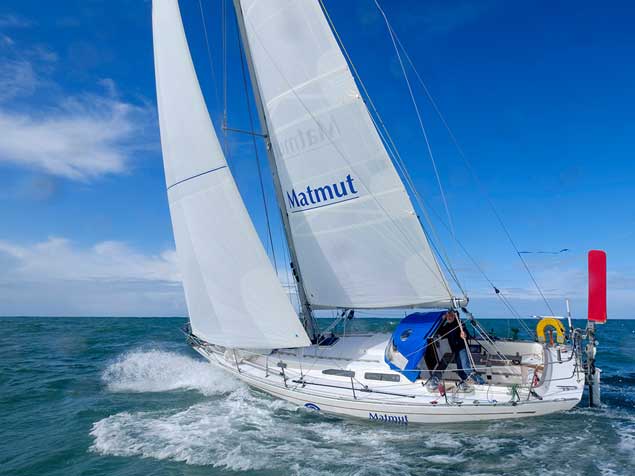 Van den Heede’s Rustler 36 Malmut before the race – the problematic through-mast bolt and tang for the lower shrouds is visible below the lower spreaders
Van den Heede’s Rustler 36 Malmut before the race – the problematic through-mast bolt and tang for the lower shrouds is visible below the lower spreaders
This has meant that second-placed Mark Slats of The Netherlands has been closing the gap, but as van den Heede was an astonishing 1470 miles ahead when his rig damage occurred, Slats has to steadily outperform him by 20% in order to be first back to les Sables d’Olonne in 2019, and since van den Heede got into the Atlantic, the Slats rate of gain has slowed.
Race Tracker here
Both van den Heede and Slats are racing Rustler 36s, a slippy Holman & Pye designed sloop of 1980 which fits neatly into the retro requirement of being a 36ft production design of 1980 or earlier with the specified closed profile, even if in the Rustler 36’s case it does result in a transom stern with a very steeply sloping rudder and a propeller in a large aperture cut from the rudder, which must make them the very devil to handle under power in astern, or indeed under power in any confined manoeuvring situation under power, where prop thrust is often the key to doing the job.
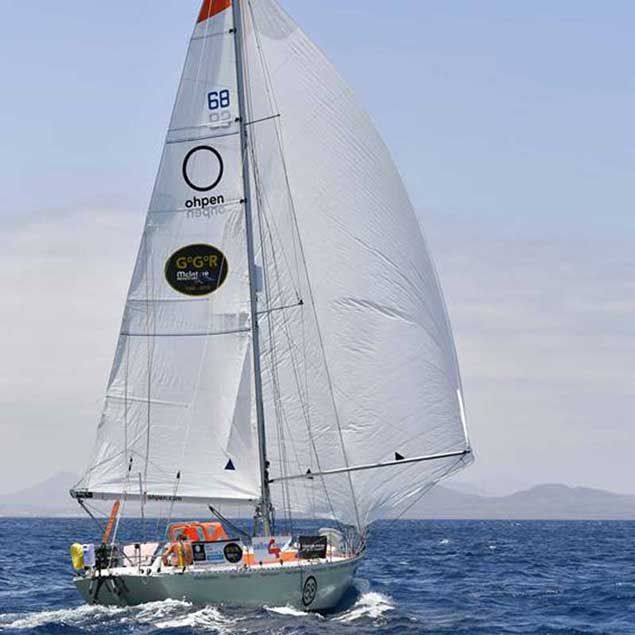 Mark Slats’ Rustler 36 Ohpen Maverick with the steeply-raked ransom and sloping rudder much in evidence
Mark Slats’ Rustler 36 Ohpen Maverick with the steeply-raked ransom and sloping rudder much in evidence
This is probably not remotely of interest in the Great Southern ocean, but as Tim Goodbody so brilliantly revealed with his J/109 in Dublin Bay last weekend, a boat which has an easily-accessed stern-boarding system and handles confidently in astern under power is a very effective rescue machine in a man-overboard situation.
But that’s another topic to which we’ll return some day. Meanwhile, the reality was that the most popular design which turned up to start the Golden Globe Golden Jubilee was the Rustler 36, something of a surprise to casual observers as most folk had initially thought the response would be something nearer Suhaili, and ketch-rigged too.
But as it happens, the one Suhaili sister-ship which was allowed in under special dispensation, Abilash Tomy’s Thuriya from India, and one of the few other ketch-rigged boats, our own Gregor McGuckin’s Biscay 36 Hanley Energy Endurance, were both dismasted in September in the mother of all storms in the middle of the southern Indian Ocean.
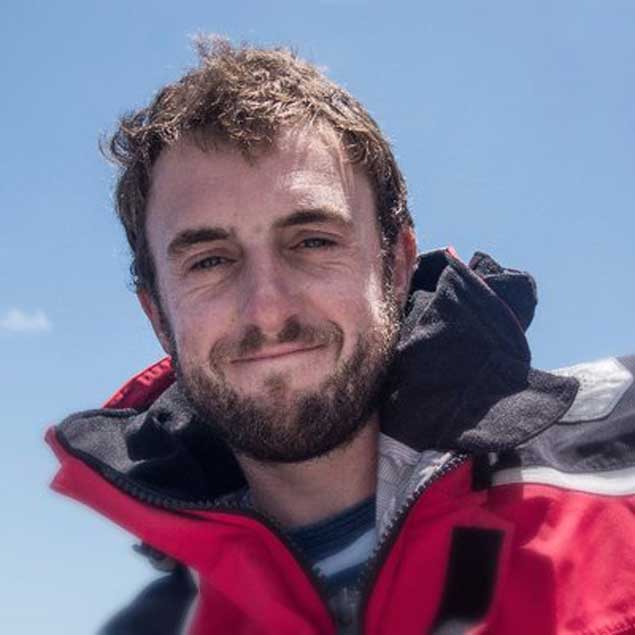 Gregor McGuckin – he was dismasted after being rolled 360-degrees in an exceptional storm in an area of the Southern Indian Ocean where Conor O’Brien had noted the power of multi-directional cross seas to build freak waves
Gregor McGuckin – he was dismasted after being rolled 360-degrees in an exceptional storm in an area of the Southern Indian Ocean where Conor O’Brien had noted the power of multi-directional cross seas to build freak waves
Their skippers were successfully retrieved by a French Fisheries Patrol vessel while McGuckin was in the midst of an heroic effort to get to the seriously-injured Tomy under jury rig. But despite promises that Thuriya would be retrieved by the Indian Navy and restored to seagoing standard, she still seems to be out there and virtually not moving at all. This suggests that she is still lying to her broken rigging, whereas McGuckin’s boat is now nearly 400 miles away nearer Australia, as before his controlled retrieval and passage towards Tomy under jury rig, he succeeded in cutting adrift all the broken spars and rigging, and the former ketch has sometimes been drifting at 1 knot and more.
The experience of McGuckin and Abilash in that “perfect storm” is of added interest in that it happened in the area of ocean where Conor O’Brien saw his ultimate breaking crest. The wind strengths were nothing like the horrific power which assaulted Tomy and McGuckin, as at the time Saoirse was running in her surprisingly speedy style before “a moderate gale” (as they used to say), and O’Brien and his helmsman observed a large waving moving along with them maybe about a mile away.
There were marked cross seas running at the time – a significant factor recorded by Gregor McGuckin – and they went to work on this big wave until it peaked out like the Matterhorn or Mount Fuji, an absolutely extraordinary pinnacle of water which then collapsed in hundreds of thousands of tons of breakers and spume.
Neither O’Brien nor his shipmate said a word to each as this all-powerful force of nature manifested itself, but afterwards in his deck log he noted that had Saoirse been caught up in it, she and her crew would have instantly been goners. As for the professional seaman who’d been helmsman at the time, as soon as they reached port in Australia, he went ashore and wasn’t seen again. It greatly annoyed O’Brien, as this was the only helmsman other than O’Brien himself who had shown he could get Saoirse to perform to her best, and O’Brien had hoped that in due course the situation would arise where their combined efforts would see Saoirse achieve the 200 miles day’s run of which he was convinced she was capable.
 Conor O’Brien as portrayed by his wife, the artist Kitty Clausen
Conor O’Brien as portrayed by his wife, the artist Kitty Clausen
He had many crew changes, but despite that and other difficulties, his underlying intention to sail home via Cape Horn was maintained. Ninety-four years ago on Sunday, it was achieved - a simple and beautiful historical fact of small craft ocean voyaging.
Today, the realities of the Golden Globe Golden Jubilee race underline the remarkable nature of what Conor O’Brien and Saoirse made into reality. He may not have been single-handed, but his crew of two were of limited experience, the boat was of extremely primitive type by today’s standards, and the elements of the unknown in what they were undertaking were beyond calculation.
Now that we know so much more about Cape Horn and the conditions which may be experienced in sailing past it, O’Brien’s feat with Saoirse in 1924 becomes that much greater. He may have died on Foynes Island in 1952, but Saoirse has lived on, and she is currently being re-built by Liam Hegarty at his Oldcourt Boatyard near her birthplace of Baltimore. In 2020, Saoirse will sail again, and we will wonder anew at the achievement of the great pioneering sailor of Limerick.
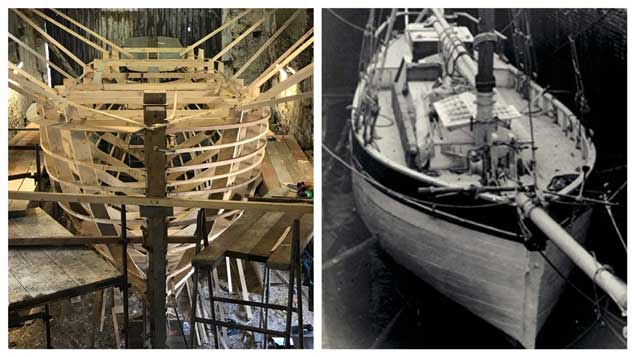 Saoirse being re-built in Oldcourt (left) and as she was in the 1930s after her global circumnavigation of 1923-25. Photos Gary MacMahon
Saoirse being re-built in Oldcourt (left) and as she was in the 1930s after her global circumnavigation of 1923-25. Photos Gary MacMahon
In recent weeks, much of the attention on the traditional boat-building Mecca of Oldcourt in West Cork has been focused around the complex moves involved in vacating the 56ft ketch Ilen from the boat-building shed writes W M Nixon. This meant safely re-locating her through the very crowded boatyard to a secure commissioning berth where a sheltering tent could be erected to allow the fitting-out work to proceed whatever the weather.
Then in time, while fitting the interior has been proceeding, there followed the “blind stepping” of the two masts which had been trucked down from the Ilen Boat-Building School in Limerick, where the massive spars and rig had been built and pre-assembled.
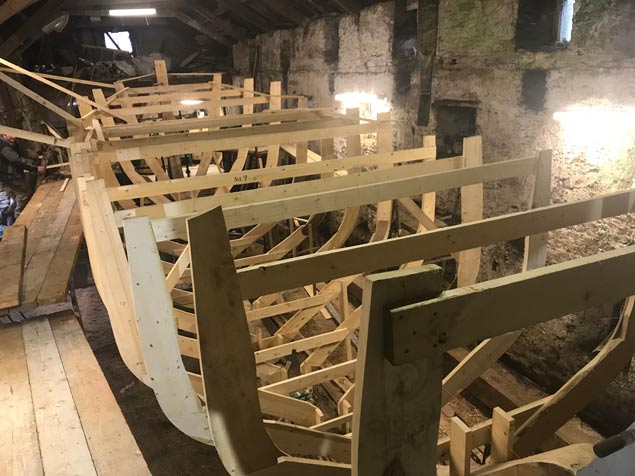 “We have a shape – we have the shape.” In boat-building terms, putting the moulds in place is just part of the process, but for the casual observer it gives a first vivid impression of what the re-built Saoirse will look like. Photo: Gary MacMahon
“We have a shape – we have the shape.” In boat-building terms, putting the moulds in place is just part of the process, but for the casual observer it gives a first vivid impression of what the re-built Saoirse will look like. Photo: Gary MacMahon
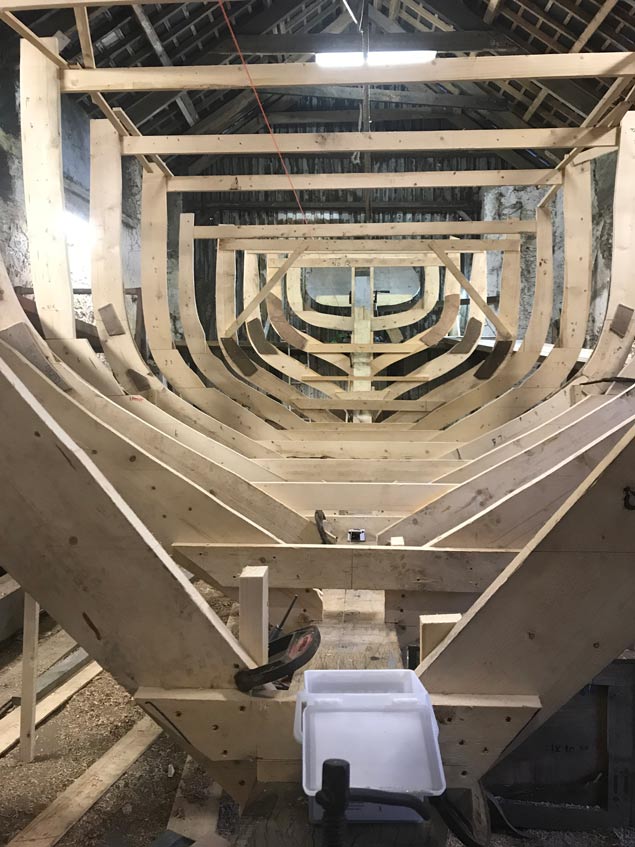 After restoring the Ilen at Oldcourt, the first stages in re-building Saoirse in the same shed provide the clearest message that a 42-footer is very much smaller than a 56-footer, yet it was the 42-footer that sailed round the world. Photo: Gary MacMahon
After restoring the Ilen at Oldcourt, the first stages in re-building Saoirse in the same shed provide the clearest message that a 42-footer is very much smaller than a 56-footer, yet it was the 42-footer that sailed round the world. Photo: Gary MacMahon
All this has been safely dealt with despite some periods of freakishly bad weather. But it had to be done on time, as the shed was needed because it had been agreed to start work in January on the re-build of Conor O’Brien’s 1922-built 42ft Saoirse. This project – for experienced sailor Fred Kinmonth of Hong Kong – will be in honour of Saoirse’s great achievement of 1923-25, the first global circumnavigation of the world by a cruising yacht south of the Great Capes.
So while much attention has been on the brightly-painted Ilen and the flurry of activity around her, in the shed shipwrights Liam Hegarty and Fachtna O’Sullivan and their team have been left in relative peace for the key initial stage of creating Saoirse’s backbone from various very substantial pieces of carefully-selected oak.
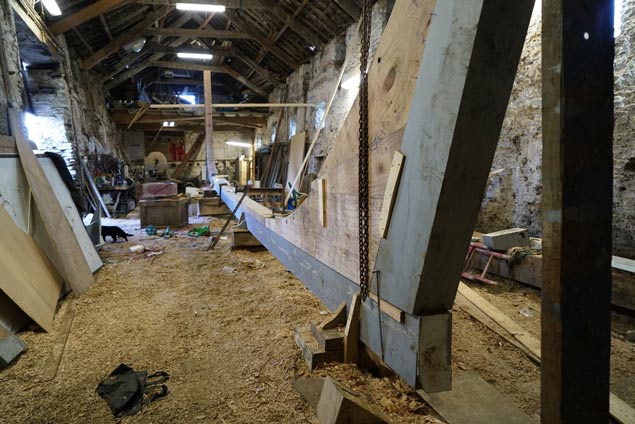 Saoirse’s backbone could only begin to come together thanks to a complex process for sourcing suitable oak. Photo: Gary MacMahon
Saoirse’s backbone could only begin to come together thanks to a complex process for sourcing suitable oak. Photo: Gary MacMahon
But as Gary MacMahon of the Ilen Project puts it: “In taking on a job like this, you have to create a new supply chain. There is no line of supply for traditional boat-building on this scale, and we had to make our own way in finding pieces of sound oak which would help to provide the myriad of shapes from which the backbone and the frames will eventually be created”.
The upshot was that if a great oak came down anywhere in Munster, they’d soon be on the spot to see if anything usable could be salvaged from it. And even then, after the processes of seasoning and so forth, that was only the beginning of the job. A piece of oak might be worked on until it was nearly ready to be installed in the backbone, but then some aspect of the almost-finished section would give out the wrong messages, and it would be discarded and an alternative piece sought from the stockpile.
 Saoirse may be significantly smaller than Ilen, but renewing her backbone has involved working with substantial pieces of oak, some of which didn’t pass the final test. Photo: Gary MacMahon
Saoirse may be significantly smaller than Ilen, but renewing her backbone has involved working with substantial pieces of oak, some of which didn’t pass the final test. Photo: Gary MacMahon
So it was patient, painstaking work, it took time, and it was best done in peace and private. But finally the makings of the backbone were in place, and there then could be visible progress – the erection on the keel, from stem to stern, of the temporary moulds which would show precisely the ultimate shape of Saoirse’s frames.
This has been taking place during the past week, and though it’s essentially a mock-up, just an integral part of the building process, nevertheless it feels as though the project has taken a mighty leap forward. And as with everything to do with Saoirse, it’s redolent with history.
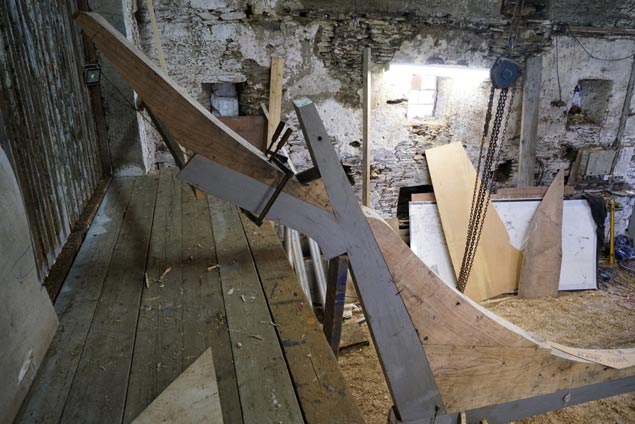 Saoirse’s sternpost – Tom Moynihan insisted on lengthening the counter beyond Conor O’Brien’s hyper-economical original design. Photo: Gary MacMahon
Saoirse’s sternpost – Tom Moynihan insisted on lengthening the counter beyond Conor O’Brien’s hyper-economical original design. Photo: Gary MacMahon
While Conor O’Brien of Foynes and Tom Moynihan of Baltimore may have sketched out Saoirse’s lines (with Moynihan insisting the inelegantly short stern be lengthened a little), their drawings were only very rudimentary. But after the great voyage, Saoirse was famous. When Conor O’Brien took her to Cowes to do the 1927 Fastnet Race, the already-legendary Cowes-based designer Uffa Fox took off the boat’s lines.
As was right and proper, the lines sketched by O’Brien and Moynihan were remarkably close to the little ship as she was finished. But it was the lines as taken off by Uffa Fox which have been used in the process whereby the moulds have been assembled and erected, and this has been a speedy process which by Friday night was providing a vision of Saoirse which has an air of reality to it.
At the end of 2017, it was still a project in planning. But now, we’re already seeing something. The dream is becoming reality.
 Saoirse’s lines as taken off by Uffa Fox in Cowes in 1927
Saoirse’s lines as taken off by Uffa Fox in Cowes in 1927
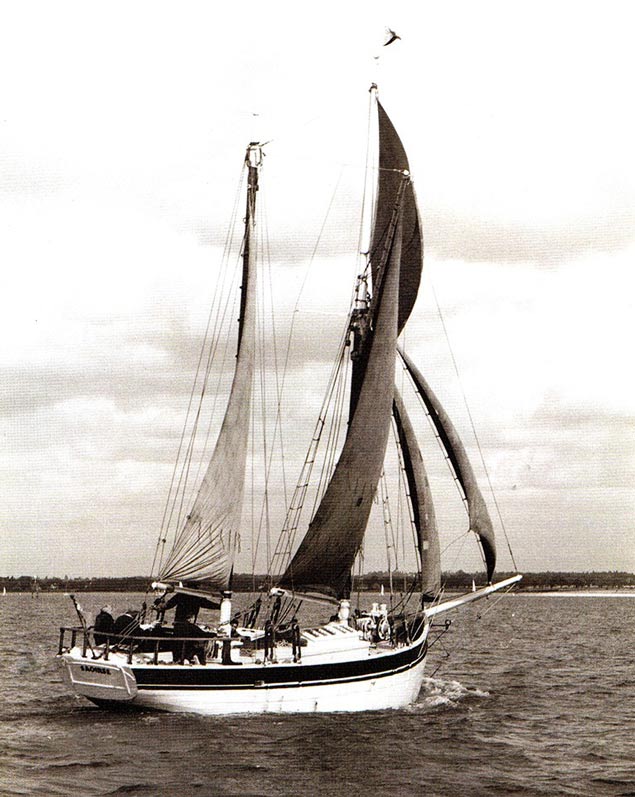 Saoirse sailing in Cornish waters during the 1950s while in the ownership of the Ruck family. Photo courtesy Gary MacMahon
Saoirse sailing in Cornish waters during the 1950s while in the ownership of the Ruck family. Photo courtesy Gary MacMahon
Dun Laoghaire Bookfest Stars Roddy Doyle & Jennifer Johnston - Irish Writers With an Unexpected Nautical Connection
“Only connect” urged the novelist E M Forster writes W M Nixon. But his idealistic concepts of emotional connection would be at some remove from the curiously coincidental nautical connections between writers Roddy Doyle and Jennifer Johnston, who are in public conversation for an hour on the final day of this week’s “Mountains to the Sea” dlr Book Festival in Dun Laoghaire.
Roddy Doyle is married to a direct descendant of Erskine Childers. And Jennifer Johnston is in private life Mrs Gilliland, married into a noted Derry family long involved with boats. Erskine Childers was of course best known as author of the 1903-published maritime thriller The Riddle of the Sands before he acquired fame as skipper of the Asgard in the 1914 Howth gun-running. And at that time, the leading sailor in the Gilliland family was Frank Gilliland, who was a pioneer in producing sailing directions and small boat charts for the northwest of Ireland, particularly Donegal, and recently came up on the radar again with Robbie Mason of Milford Haven undertaking a restoration of his 1938 Scottish fishing boat-style motor cruiser Blue Hills.


Both Childers and Gilliland were members of the oldest cruising organisation in the world, the 1880-founded Royal Cruising Club. But although both served in various sections of the Royal Naval Reserve through the 1914-18 War, by the time that war ended they had very different notions as to the future of Ireland in the post-war turbulence which eventually led to the War of Independence, the Partition which created Northern Ireland in 1921, and the Civil War in the new Irish Free State. Yet while they may have viewed some things very differently, in 1919 they combined on a small but significant project which was to have longterm effects on Irish sailing.
Both were acquainted with a sailor from Foynes called Conor O’Brien, Gilliland probably through the Naval Reserve connections, while Childers knew O’Brien from the time he had brought his ketch Kelpie along to assist in the 1914 gun-running. Whatever their origins, the connections were such that when the Foynes man sought to join the Royal Cruising Club in September 1919, he was proposed by Frank Gilliland and seconded by Erskine Childers, and duly got in.
Looked at across the series of events which occurred before and since, it was an extraordinary and unlikely combination of people and purposes. But it meant that Conor O’Brien now had access to a recognised channel for acknowledgement of his cruising achievements, which became serious when he departed Dun Laoghaire on June 20th 1923 for his voyage round the world south of the Great Capes with the new 42ft Baltimore-built Saoirse.
By this time, Erskine Childers had been executed by a firing squad of the Government of the new Irish Free State as an armed anti-Treaty rebel. And Frank Gilliland was on his way to becoming the Aide-de-Camp to the first Governor of Northern Ireland. But O’Brien sailed blithely along on his epic voyage, flying the tricolour ensign of the new Irish state whenever possible, yet submitting logs each year to the annual competition of the Royal Cruising Club.
Although many members of the RCC had severe doubts about having anything whatever to do with the new Ireland, the hugely-experienced adjudicator Claud Worth, RCC Vice Commodore, had little hesitation in awarding O’Brien the club’s premier trophy, the Challenge Cup, three years on the trot in recognition of his remarkable achievement.

Not only that, but when O’Brien wrote his book Across Three Oceans about the voyage, Claud Worth willingly supplied a foreword which gave the entire venture an official status which it has held ever since. In it, he memorably commented:
“Mr O’Brien’s plain seamanlike account is so modestly written that a casual reader might miss its full significance” wrote Worth. “But anyone who knows anything of the sea, following the course of the vessel day by day on the chart, will realize the good seamanship, vigilance and endurance required to drive this little bluff-bowed vessel, with her foul uncoppered bottom, at speeds from 150 to 170 miles per day, as well as handling the weight of wind and sea which must sometimes have been encountered”.

This level of support from a man regarded as God-like in his wisdom by the world of cruising was the ultimate level of recognition, and O’Brien’s reputation was secure, regardless of the fact that some found him at personal level to be a leading member of the Awkward Squad. It’s possible that his achievements were such that he would have so impressed Claud Worth regardless of his RCC membership. But the fact that he’d become a member in 1919 – albeit with the most unlikely combination of supporters – had greatly smoothed the way.
And as next Sunday’s exchange of ideas between Jennifer Johnston and Roddy Doyle is taking place beside the harbour where Saoirse’s great voyage began and ended over the space of exactly two years between 1923 and 1925, the coincidences are complete. Their conversation is on Sunday March 25th at noon in dlr Lexicon Level 4, booking recommended.
Restored Historic Ketch Ilen Starts to Get Authentic Rigging Through In-House Production
When the restoration project on the 1926-built 56ft Conor O’Brien/Tom Moynihan Falkland Islands Trading Ketch got under way at two locations – Liam Hegarty’s boat-building shed in the former Cornstore at Oldcourt near Baltimore, and the Ilen Boat-building School premises in Limerick – it was expected that final jobs such as making up the rigging and creating the sails would be contracted out to specialists writes W M Nixon.
But while the plan is still in place to have the sails made in traditional style by specialist sailmakers, Gary MacMahon and his team in the Ilen Boat-building School came to the realisation that they’d made so many international contacts over the years while the restoration has been under way that, if they could just get the right people’s schedules to harmonise, then they could learn how to make up the rigging in their own workshops as part of the broader training programme.
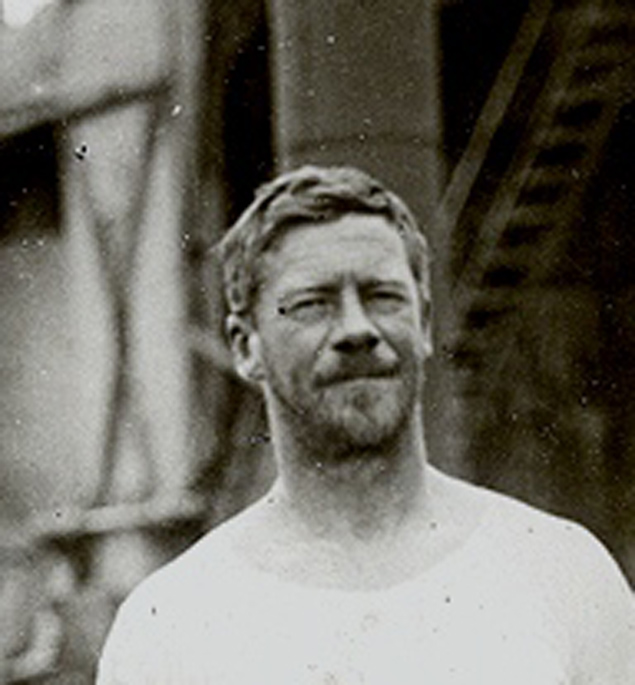 Conor O’Brien in 1926, when he delivered Ilen to the Falklands. He had received the order for the new ketch as a result of his visit to the Falkland Islands during his round the world voyage with the 42ft ketch Saoirse in 1923-25
Conor O’Brien in 1926, when he delivered Ilen to the Falklands. He had received the order for the new ketch as a result of his visit to the Falkland Islands during his round the world voyage with the 42ft ketch Saoirse in 1923-25
As a result, the Ilen Boat-building School became a hive of activity over the Bank Holiday Weekend and beyond, for that was the only time when noted heavy rigging experts Trevor Ross, who is originally from New Zealand, and Captain Piers Alvarez, master of the 45-metre barque-rigged tall ship Kaskelot, were both available to make their voluntary instructional contributions to the project.
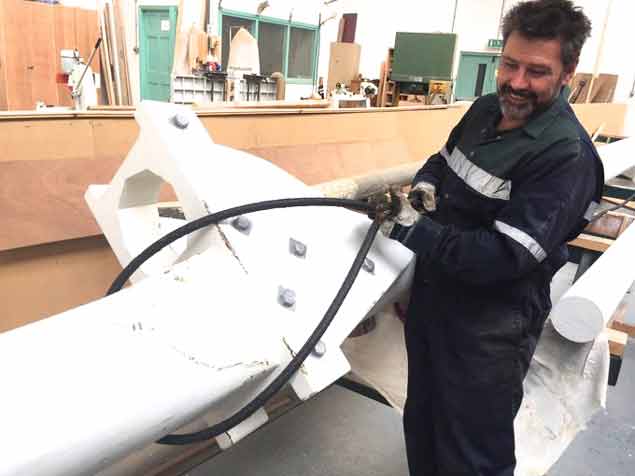 Trevor Ross with a new eye splice in the Ilen Boat-building School in Limerick. Photo: Gary MacMahon
Trevor Ross with a new eye splice in the Ilen Boat-building School in Limerick. Photo: Gary MacMahon
 The re-creation of Ilen’s rig, as developed by Trevor Ross with the late Theo Rye
The re-creation of Ilen’s rig, as developed by Trevor Ross with the late Theo Rye
Trevor Ross was professionally at sea for ten years, during which time he became fascinated with traditional rigging techniques. Though he now works ashore, his interest in traditional rigging and sail training is greater than ever - so much so that he worked with the late Theo Rye in finalizing the design of Ilen’s rig to match the original from Conor O’Brien’s day, while ensuring that it is practical in modern terms both for requirements of efficiency and safety.
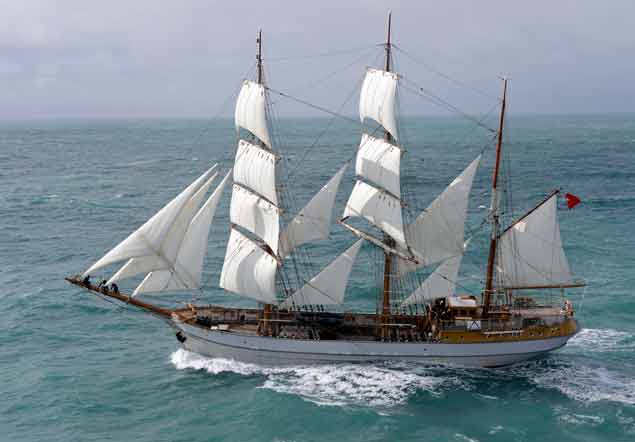 Captain Piers Alvarez’s current command is the 45-metre barque Kaskelot
Captain Piers Alvarez’s current command is the 45-metre barque Kaskelot
Piers Alvarez grew up in English cider country near the broad River Severn, but his personal horizons were far beyond apple growing. When he was 15, the captain of the famous square rigger Soren Larsen came to live in the village, which gave Piers’ father the opportunity to sign on his restless son as an Able Seaman at least for the duration of the school holidays, but the boy became hooked on the sea.
More than thirty years later, the love of seafaring and traditional ships is undimmed. Although Piers’ maritime career has also taken in tugs, superyachts and ice-classed research vessels, his current role in command of the Kaskelot perfectly chimes with his most passionate interests, and he has been fascinated by the entire Ilen project from an early stage.
So when the possibility arose of spending time in Limerick working along with his old shipmate Trevor Ross on the rigging for Ilen as a training project for the Ilen School’s intake, he readily gave up a week of his leave to teach the Ilen’s build team and future crew everything he knows, while moving a key part of the Ilen plan along the path of progress.
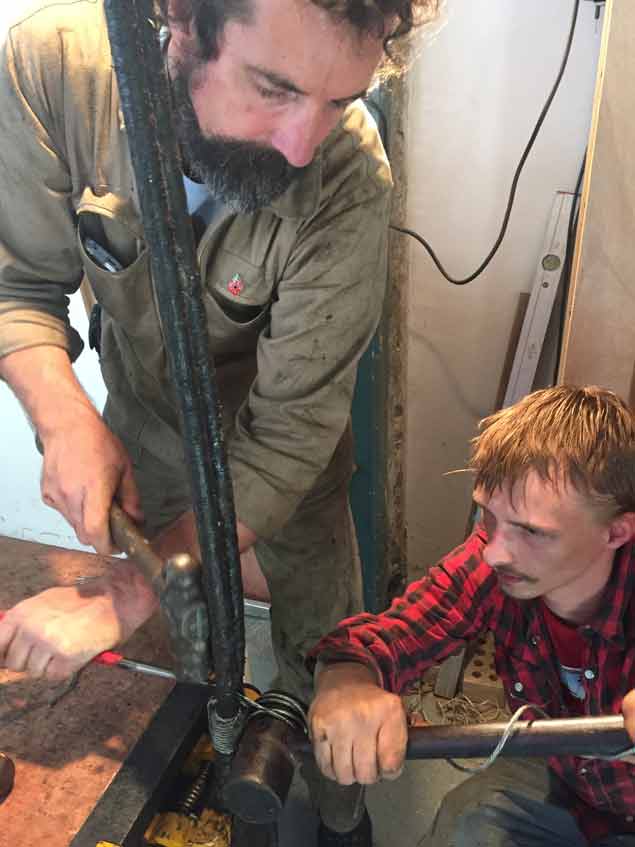 Piers Alvarez and trainee Elan Broadly busy with their work in Limerick
Piers Alvarez and trainee Elan Broadly busy with their work in Limerick
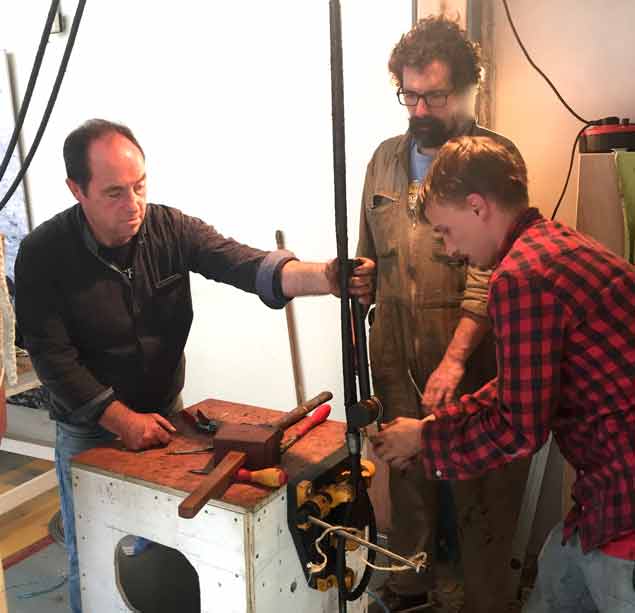 Ilen School Instructor James Madigan (left) with Piers Alvarez and Elan Broadly, immersed in their learning work while everyone else is on holiday. Photo: Gary MacMahon
Ilen School Instructor James Madigan (left) with Piers Alvarez and Elan Broadly, immersed in their learning work while everyone else is on holiday. Photo: Gary MacMahon
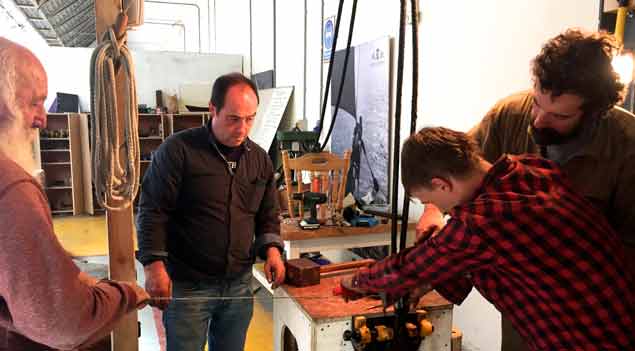 Team work. (Left to right) Liam O’Donoghue, James Madigan, and Elan Broadly on a steep learning curve with Piers Alvarez. Photo: Gary MacMahon
Team work. (Left to right) Liam O’Donoghue, James Madigan, and Elan Broadly on a steep learning curve with Piers Alvarez. Photo: Gary MacMahon
Modern amateur sailors, accustomed to today’s rigging where a terminal can be fitted in a seemingly-simple machine with the press of a button, can scarcely imagine the patient effort and skill which goes into making an eye splice in wire rigging which is of such a weight that, to most of us, it looks more like working with steel hawsers.
This is hard graft, but very rewarding in the result, and the satisfaction found in the effort expended. Much of it is done entirely by hand, but now and again that lethal multiple tool, the angle-grinder, will speed up a finishing job.
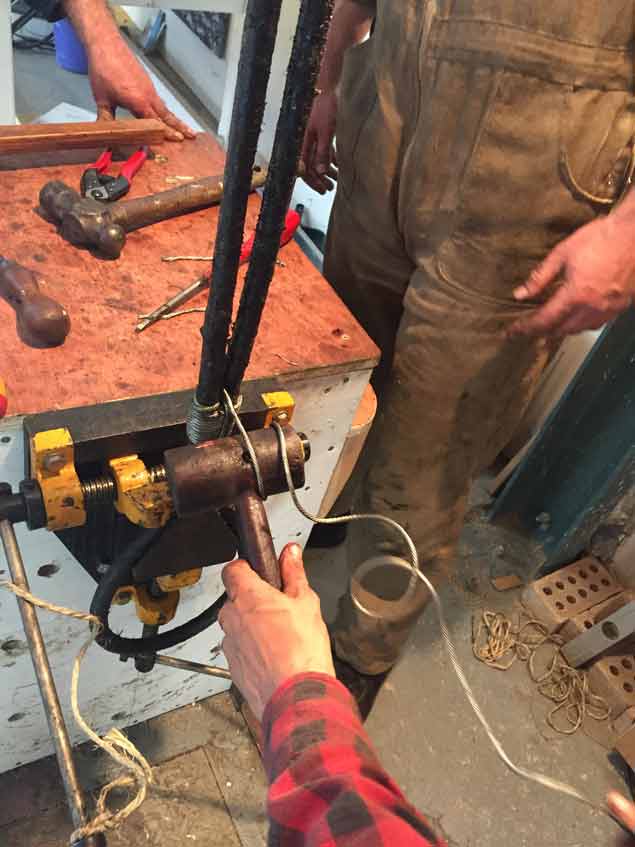 Some of the tools used in setting up traditional rigging are of very ancient origin…………….Photo: Gary MacMahon
Some of the tools used in setting up traditional rigging are of very ancient origin…………….Photo: Gary MacMahon
 ….but inevitably an angle grinder will be used at some stage, and Piers Alvarez is ace with it. Photo: Gary MacMahon
….but inevitably an angle grinder will be used at some stage, and Piers Alvarez is ace with it. Photo: Gary MacMahon
When finished, the neatly parcelled eye-spliced shrouds will fit the re-shaped mast like a glove, while at the other end, the shrouds will be tensioned by traditional lanyards through dead-eyes which have been made in Limerick from tough greenheart timber. It’s a long way from a drum of raw steel wire and a still squared hounds area to be progressed into something which will function on the massive mast in smooth partnership, providing Ilen with her sailing power. And in Limerick over the holiday week, it provided an unusually satisfying way to learn something new and useful.
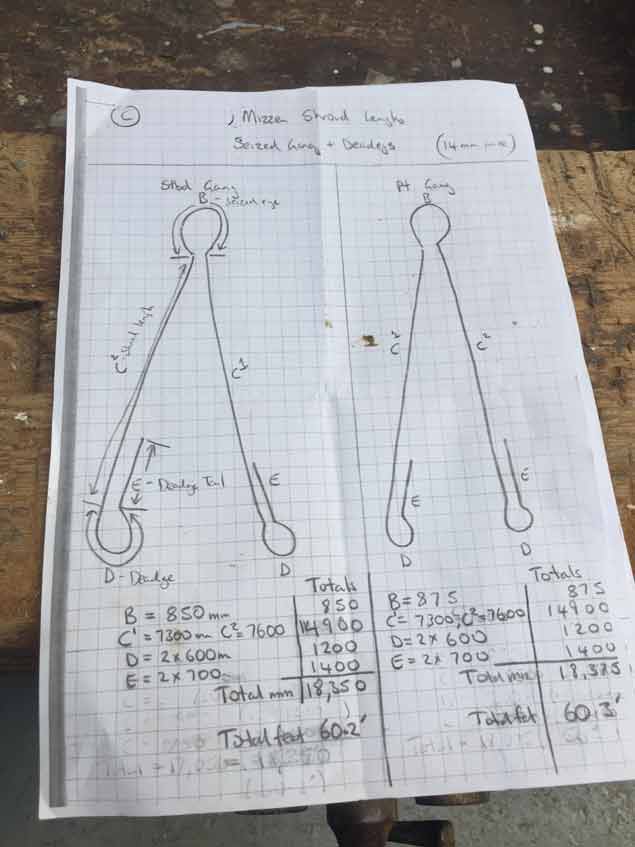 With the simplest of work drawings, an experienced rigger can turn a piece of hefty steel wire into a serviceable piece of rigging. Photo: Gary MacMahon
With the simplest of work drawings, an experienced rigger can turn a piece of hefty steel wire into a serviceable piece of rigging. Photo: Gary MacMahon
 The thick steel wire in its raw state is a daunting sight. Photo: Gary MacMahon
The thick steel wire in its raw state is a daunting sight. Photo: Gary MacMahon
 The lower ends of the shrouds will be attached to the chainplates by lanyards rove through deadeyes made from greenheart, seen here at an early stage of the shaping process in Limerick. Photo: Gary MacMahon
The lower ends of the shrouds will be attached to the chainplates by lanyards rove through deadeyes made from greenheart, seen here at an early stage of the shaping process in Limerick. Photo: Gary MacMahon
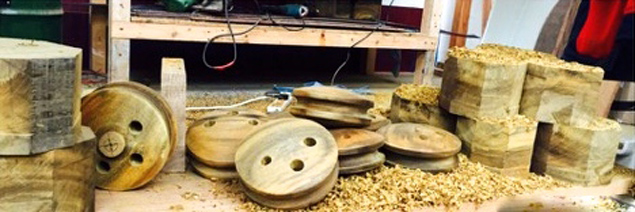 “Series production” of dead-eyes. Photo: Gary MacMahon
“Series production” of dead-eyes. Photo: Gary MacMahon
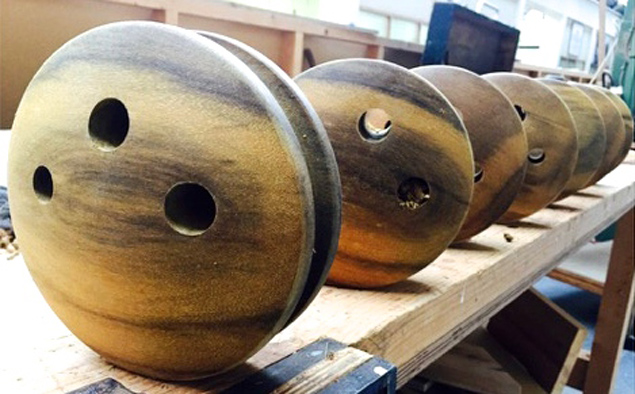 Dead-eyes at the final stage of their creation. All that remains to be done is to shape grooves to allow a fair downward lead for the lanyards. Photo: Gary MacMahon
Dead-eyes at the final stage of their creation. All that remains to be done is to shape grooves to allow a fair downward lead for the lanyards. Photo: Gary MacMahon




























